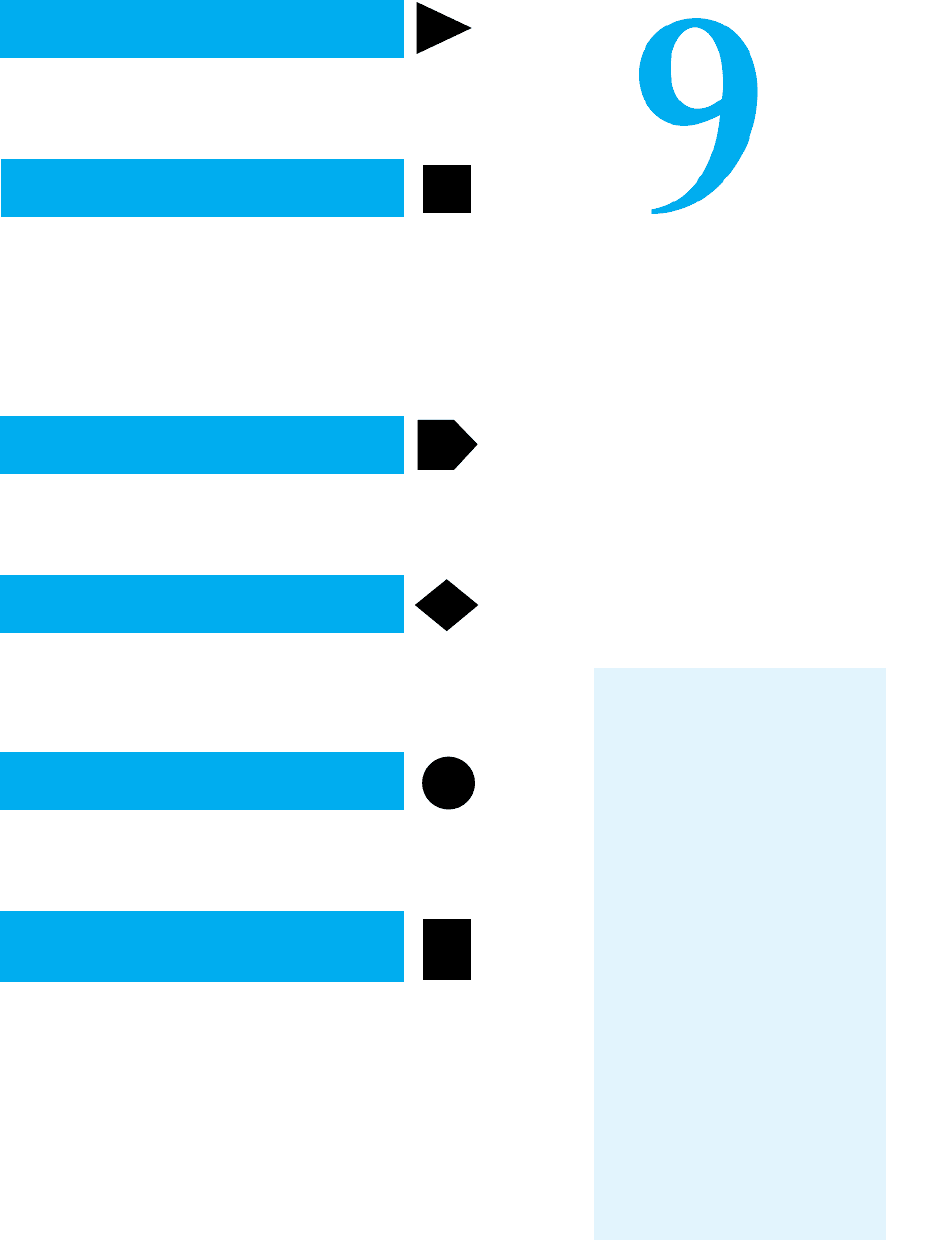Whetten David A., Cameron Kim S. Developing management skills
Подождите немного. Документ загружается.


SKILL PRACTICE
Analysis of “Biological Warfare”
QUESTION:ANALYSIS:
Is it a group or individual problem? Group because the task affects many
employees.
Is there a quality requirement? Yes, because one bid may clearly be
better than another.
Does the manager have needed information? No; the manager must obtain
information from others.
Is the problem structured or unstructured? Structured, because standard routines
are involved.
Do subordinates have to accept the Yes, because they will have discretion
decision? in implementation.
Are subordinates likely to accept the Yes, probably, because of the benefit
decision? to the firm.
Does everyone share a common goal? No; whereas all want the firm to be
profitable, some are ideologically
opposed to this kind of business.
Is conflict among subordinates likely? Yes, since ideological factors may
become relevant.
Do subordinates have needed information? No; subordinates are inexperienced.
Choice: Make a decision by yourself, without sharing the problem with subordinates, after
having obtained the necessary information. You may or may not share the problem with
subordinates to discuss alternatives, but regardless, the decision should be yours alone.
EMPOWERING AND DELEGATING CHAPTER 8 487
This page intentionally left blank

489
Building
Effective
Teams and
Teamwork
SKILL
DEVELOPMENT
OBJECTIVES
■ DIAGNOSE AND FACILITATE
TEAM DEVELOPMENT
■ BUILD HIGH-PERFORMANCE
TEAMS
■ FACILITATE TEAM LEADERSHIP
■ FOSTER EFFECTIVE TEAM
MEMBERSHIP
SKILL
ASSESSMENT
■ Team Development Behaviors
■ Diagnosing the Need for Team Building
SKILL
LEARNING
■ Developing Teams and Teamwork
■ The Advantages of Teams
■ Team Development
■ Leading Teams
■ Team Membership
■ Summary
■ Behavioral Guidelines
SKILL
ANALYSIS
■ The
Tallahassee Democrat’s
ELITE Team
■ The Cash Register Incident
SKILL
PRACTICE
■ Team Diagnosis and Team Development Exercise
■ Winning the War on Talent
■ Team Performance Exercise
SKILL
APPLICATION
■ Suggested Assignments
■ Application Plan and Evaluation
SCORING KEYS
AND
COMPARISON DATA

490 CHAPTER 9 BUILDING EFFECTIVE TEAMS AND TEAMWORK
SKILL
ASSESSMENT
DIAGNOSTIC SURVEYS FOR BUILDING
EFFECTIVE TEAMS
TEAM DEVELOPMENT BEHAVIORS
Step 1: Before you read the material in this chapter, please respond to the following
statements by writing a number from the rating scale below in the left-hand column (Pre-
Assessment). Your answers should reflect your attitudes and behavior as they are now,
not as you would like them to be. Be honest. This instrument is designed to help you dis-
cover your level of competency in building effective teams so you can tailor your learning
to your specific needs. When you have completed the survey, use the scoring key at the
end of the chapter to identify the skill areas discussed in this chapter that are most impor-
tant for you to master.
Step 2: After you have completed the reading and the exercises in this chapter and, ide-
ally, as many as you can of the Skill Application assignments at the end of this chapter,
cover up your first set of answers. Then respond to the same statements again, this time
in the right-hand column (Post-Assessment). When you have completed the survey, use
the scoring key at the end of the chapter to measure your progress. If your score remains
low in specific skill areas, use the behavioral guidelines at the end of the Skill Learning
section to guide further practice.
Rating Scale
1 Strongly disagree
2 Disagree
3 Slightly disagree
4 Slightly agree
5 Agree
6 Strongly agree
Assessment
Pre- Post-
When I am in the role of leader in a team:
______ ______ 1. I know how to establish credibility and influence among team members.
______ ______ 2. I behave congruently with my stated values and I demonstrate a high degree of
integrity.
______ ______ 3. I am clear and consistent about what I want to achieve.
______ ______ 4. I create positive energy by being optimistic and complimentary of others.
______ ______ 5. I build a common base of agreement in the team before moving forward with task
accomplishment.
______ ______ 6. I encourage and coach team members to help them improve.
______ ______ 7. I share information with team members and encourage participation.
______ ______ 8. I articulate a clear, motivating vision of what the team can achieve, along with specific
short-term goals.

BUILDING EFFECTIVE TEAMS AND TEAMWORK CHAPTER 9 491
When I am in the role of team member:
______ ______ 9. I know a variety of ways to facilitate task accomplishment in the team.
______ ______ 10. I know a variety of ways to help build strong relationships and cohesion among team
members.
______ ______ 11. I confront and help to overcome negative, dysfunctional, or blocking behaviors by
others.
______ ______ 12. I shift roles from facilitating task accomplishment to helping build trusting relation-
ships among members, depending on what the team needs to move forward.
When I desire to make my team perform well, regardless of whether I am a leader or member:
______ ______ 13. I am knowledgeable about the different stages of team development experienced by
most teams.
______ ______ 14. I help establish clear expectations and purpose as well as help team members feel
comfortable with one another at the outset of a team.
______ ______ 15. I encourage team members to become as committed to the success of the team as to
their own personal success.
______ ______ 16. I help team members become committed to the team’s vision and goals.
______ ______ 17. I help the team avoid groupthink by making sure that sufficient diversity of opinions
are expressed in the team.
______ ______ 18. I can diagnose and capitalize on my team’s core competencies, or unique strengths.
______ ______ 19. I encourage the team to continuously improve as well as to seek for dramatic
innovations.
______ ______ 20. I encourage exceptionally high standards of performance and outcomes that far
exceed expectations.
DIAGNOSING THE NEED FOR TEAM BUILDING
Teamwork has been found to dramatically affect organizational performance. Some man-
agers have credited teams with helping them to achieve incredible results. On the other
hand, teams don’t work all the time in all organizations. Therefore, managers must decide
when teams should be organized. To determine the extent to which teams should be built
in your organization, complete the instrument below.
Think of an organization in which you participate (or will participate) that produces
a product or service. Answer these questions with that organization in mind. Write a
number from a scale of 1 to 5 in the blank at the left; 1 indicates that there is little evi-
dence; 5 indicates there is a lot of evidence. Comparison data is provided at the end of the
chapter.
1. Output has declined or is lower than desired.
2. Complaints, grievances, or low morale are present or are increasing.
3. Conflicts or hostility between members is present or is increasing.
4. Some people are confused about assignments, or their relationships with other people
are unclear.
5. Lack of clear goals and lack of commitment to goals exist.
6. Apathy or lack of interest and involvement by members is in evidence.
7. Insufficient innovation, risk taking, imagination, or initiative exists.

492 CHAPTER 9 BUILDING EFFECTIVE TEAMS AND TEAMWORK
8. Ineffective and inefficient meetings are common.
9. Working relationships across levels and units are unsatisfactory.
10. Lack of coordination among functions is apparent.
11. Poor communication exists; people are afraid to speak up; listening isn’t occurring;
and information isn’t being shared.
12. Lack of trust exists among members and between members and senior leaders.
13. Decisions are made that some members don’t understand, or with which they don’t
agree.
14. People feel that good work is not rewarded or that rewards are unfairly administered.
15. People are not encouraged to work together for the good of the organization.
16. Customers and suppliers are not part of organizational decision making.
17. People work too slowly and there is too much redundancy in the work being done.
18. Issues and challenges that require the input of more than one person are being faced.
19. People must coordinate their activities in order for the work to be accomplished.
20. Difficult challenges that no single person can resolve or diagnose are being faced.
SOURCE: Adapted from Diagnosing the Need for Team Building, William G. Dyer. (1987) Team Building: Issues
and Alternatives. Reading, MA: Addison Wesley. Reprinted with permission of Addison Wesley.

BUILDING EFFECTIVE TEAMS AND TEAMWORK CHAPTER 9 493
SKILL
LEARNING
Developing Teams and Teamwork
Near the home of one of the authors of this book,
scores of Canada geese spend the winter. They fly over
the house to the nature pond nearby almost every
morning. What is distinctive about these flights is that
the geese always fly in a V pattern. The reason for this
pattern is that the flapping wings of the geese in front
create an updraft for the geese that follow. This V pat-
tern increases the range of the geese collectively by
71 percent compared to flying alone. On long flights,
after the lead goose has flown at the front of the V for
a while, it drops back to take a place in the V where
the flying is easier. Another goose then takes over the
lead position, where the flying is most strenuous. If a
goose begins to fly out of formation, it is not long
before it returns to the V because of the resistance it
experiences when not supported by the wing flapping
of the other geese.
Another noticeable feature of these geese is the
loud honking that occurs when they fly. Canada geese
never fly quietly. One can always tell when they are in
the air because of the noise. The reason for the honking
is not random, however. It occurs among geese in the
rear of the formation in order to encourage the lead
goose. The leader doesn’t honk—just those who are
supporting and urging on the leader. If a goose is shot,
becomes ill, or falls out of formation, two geese break
ranks and follow the wounded or ill goose to the ground.
There they remain, nurturing their companion, until it is
either well enough to return to the flock or it dies.
This remarkable phenomenon serves as an apt
metaphor for our chapter on teamwork. The lessons
garnered from the flying V formation help highlight
important attributes of effective teams and skillful
teamwork. For example:
❏ Effective teams have interdependent members.
Like geese, the productivity and efficiency of an
entire unit is determined by the coordinated,
interactive efforts of all its members.
❏ Effective teams help members be more effi-
cient working together than alone. Like geese,
effective teams outperform even the best indi-
vidual’s performance.
❏ Effective teams function so well that they
create their own magnetism. Like geese,
team members desire to affiliate with a team
because of the advantages they receive from
membership.
❏ Effective teams do not always have the same
leader. As with geese, leadership responsibility
often rotates and is shared broadly as teams
develop over time.
❏ In effective teams, members care for and nur-
ture one another. No member is devalued or
unappreciated. All are treated as an integral
part of the team.
❏ Effective teams have members who cheer for
and bolster the leader, and vice versa. Mutual
encouragement is given and received by each
member.
❏ Effective teams have a high level of trust among
members. Members demonstrate integrity and
are interested in others’ success as well as their
own.
Because any metaphor can be carried to extremes,
we don’t wish to overemphasize the similarities
between Canada geese and work teams. On the other
hand, these seven attributes of effective teams do serve
as the nucleus of this chapter. They will help us iden-
tify ways for you to improve your abilities to lead a
team, to be an effective team member, and to foster
effective team processes. Our intent is to identify
proven techniques and skills that will help you func-
tion more effectively in team settings.
One important reason for this emphasis on teams
is that participation in teams is fun for most people.
There is something inherently attractive about being
engaged in teamwork. Consider, for example, the two
advertisements that appeared next to one another in a
metropolitan newspaper, both seeking to fill the same
type of position. They are reproduced in Figure 9.1.
While neither advertisement is negative or inappropri-
ate, they are noticeably different. Which job would
you rather take? Which firm would you rather work
for? For most of us, the team-focused job seems much
more desirable. This chapter focuses on helping you to
flourish in these kinds of team settings.

494 CHAPTER 9 BUILDING EFFECTIVE TEAMS AND TEAMWORK
Our Team Needs One Good
Multiskilled Maintenance Associate
American Automotive Manufacturing
P.O. Box 616
Ft. Wayne, Indiana 48606
Include phone number. We respond to all
applicants.
Maintenance Technician/Welder
National Motors Corporation
5169 Blane Hill Center
Springfield, Illinois 62707
Our Team is down one good player. Join our
group of multiskilled Maintenance Associates
who work together to support our assembly
teams at American Automotive Manufacturing.
We are looking for a versatile person with skills
in one or more of the following: ability to set
up and operate various welding machinery,
knowledge in electric arc and M.I.G. welding,
willingness to work on detailed projects for
extended time periods, and general overall
knowledge of the automobile manufacturing
process. Willingness to learn all maintenance
skills a must. You must be a real team player,
have excellent interpersonal skills, and be
motivated to work in a highly participative
environment.
Send qualifications to:
Leading automotive manufacturer looking for
Maintenance Technician/Welder. Position
requires the ability to set up and operate
various welding machinery and a general
knowledge of the automobile production
process. Vocational school graduates or 3–5
years of on-the-job experience required.
Competitive salary, full benefits, and tuition
reimbursement offered.
Interviews Monday, May 6, at the Holiday Inn
South, 3000 Semple Road, 9:00
A.M. to 7:00 P.M.
Please bring pay stub as proof of last
employment.
AMM
NMC
Figure 9.1 A Team-Oriented and a Traditional Advertisement for a Position
The Advantages of Teams
Whether one is a manager, a subordinate, a student, or
a homemaker, it is almost impossible to avoid being a
member of a team. Some form of teamwork permeates
most people’s daily lives. Most of us are members of
discussion groups, friendship groups, neighborhood
groups, sports teams, or even families in which tasks
are accomplished and interpersonal interaction occurs.
Teams, in other words, are simply groups of people
who are interdependent in the tasks they perform,
affect one another’s behavior through interaction, and
see themselves as a unique entity. What we discuss in
this chapter is applicable to team activity in most kinds
of settings, although we focus mainly on teams and
teamwork in employing organizations rather than in
homes, classrooms, or in the world of sports. The prin-
ciples of effective team performance, team leadership,
and team participation we address here, however, are
virtually the same across all these kinds of teams.
For example, empowered teams, autonomous work
groups, semiautonomous teams, self-managing teams,
self-determining teams, crews, platoons, cross-functional
teams, top management teams, quality circles, proj-
ect teams, task forces, virtual teams, emergency response
teams, and committees are all examples of the various
manifestations of teams and teamwork that appear in the
scholarly literature, and research has been conducted
on each of these forms of teams. Our focus is on helping
you develop skills that are relevant in most or all
these kinds of situations, whether as a team leader or a
team member.
Developing team skills is important because of the
tremendous explosion in the use of teams in work orga-
nizations over the last decade. For example, 79 percent
of Fortune 1000 companies reported that they used
self-managing work teams, and 91 percent reported
that employee work groups were being utilized
(Lawler, 1998; Lawler, Mohrman, & Ledford, 1995).
More than two thirds of college students participate in
an organized team, and almost no one can graduate
from a business school anymore without participating
in a team project or a group activity. Teams are ubiqui-
tous in both work life and at school. Possessing the

BUILDING EFFECTIVE TEAMS AND TEAMWORK CHAPTER 9 495
❏ Dana Corporation’s Minneapolis valve plant
trimmed customer lead time from six months
to six weeks.
❏ General Mills plants became 40 percent more
productive than plants operating without
teams.
❏ A garment-making plant increased its pro-
ductivity 14 percent by adopting a team-based
production system.
Table 9.1 reports the positive relationships
between employee involvement in teams and several
dimensions of organizational and worker effectiveness.
Lawler, Mohrman, and Ledford (1995) found that
among firms that were actively using teams, both
organizational and individual effectiveness were above
average and improving in virtually all categories of per-
formance. In firms without teams or in which teams
were infrequently used, effectiveness was average or
low in all categories.
Of course, a variety of factors can affect the per-
formance and usefulness of teams. Teams are not
inherently effective just because they exist. A Sports
Illustrated cover story, for example, labeled the Los
Angeles Clippers NBA basketball team the worst team
in the history of professional sports from inception
to the year 2000 (Lidz, 2000)—evidence that just
because a group of talented people get together does
not mean that an effective team can be created.
Hackman (1993) identified a set of common inhibitors
to effective team performance, including reward-
ing and recognizing individuals instead of the team,
not maintaining stability of membership over time, not
providing team members with autonomy, not fostering
interdependence among team members, and failing to
orient all team members. In contradiction to Peters’
comments about the universal utility of teams,
Verespei (1990) observed:
All too often corporate chieftains read the suc-
cess stories and ordain their companies to
adopt work teams—NOW. Work teams don’t
always work and may even be the wrong solu-
tion to the situation in question.
The instrument, called “Diagnosing the Need for
Team Building” in the Skill Assessment section of this
chapter, helps identify the extent to which the work
teams in which you are involved are performing effec-
tively, and the extent to which they need team building.
Often, teams can take too long to make decisions, they
can drive out effective action by becoming too insular,
and they can create confusion, conflict, and frustration
ability to lead and manage teams and teamwork, in
other words, has become a commonplace requirement
in most organizations. In one survey, the most desired
skill of new employees was found to be the ability to
work in a team (Wellins, Byham, & Wilson, 1991).
One noted management consultant, Tom Peters
(1987), even asserted:
Are there any limits to the use of teams? Can we
find places or circumstances where a team
structure doesn’t make sense? Answer: No, as
far as I can determine. That’s unequivocal, and
meant to be. Some situations may seem to lend
themselves more to team-based management
than others. Nonetheless, I observe that the
power of the team is so great that it is often wise
to violate apparent common sense and force a
team structure on almost anything. (p. 306)
One reason for the escalation in the desirability of
teamwork is that increasing amounts of data show
improvements in productivity, quality, and morale when
teams are utilized. Many companies have attributed
their improvements in performance directly to the insti-
tution of teams in the workplace (Cohen & Bailey, 1997;
Guzzo & Dickson, 1996; Hamilton, Nickerson, &
Owan, 2003; Katzenbach & Smith, 1993; Senge, 1991).
For example, by using teams in their organizations:
❏ Shenandoah Life Insurance Company in
Roanoke, Virginia, saved $200,000 annually
because of reduced staffing needs, while
increasing its volume 33 percent.
❏ Westinghouse Furniture Systems increased
productivity 74 percent in three years.
❏ AAL increased productivity by 20 percent, cut
personnel by 10 percent, and handled 10 percent
more transactions.
❏ Federal Express cut service errors by 13 percent.
❏ Carrier reduced unit turnaround time from
two weeks to two days.
❏ Volvo’s Kalamar facility reduced defects by
90 percent.
❏ General Electric’s Salisbury, North Carolina,
plant increased productivity by 250 percent
compared to other GE plants producing the
same product.
❏ Corning cellular ceramics plant decreased defect
rates from 1,800 parts per million to 9 parts per
million.
❏ AT&T’s Richmond operator service increased
service quality by 12 percent.

496 CHAPTER 9 BUILDING EFFECTIVE TEAMS AND TEAMWORK
Table 9.1 Impact of Involvement in Teams on Organizations and Workers
PERFORMANCE CRITERIA PERCENT INDICATING IMPROVEMENT
Changed management style to more participatory 78
Improved organizational processes and procedures 75
Improved management decision making 69
Increased employee trust in management 66
Improved implementation of technology 60
Elimination of layers of management supervision 50
Improved safety and health 48
Improved union-management relations 47
PERFORMANCE CRITERIA PERCENT INDICATING POSITIVE IMPACT
Quality of products and services 70
Customer service 67
Worker satisfaction 66
Employee quality of work life 63
Productivity 61
Competitiveness 50
Profitability 45
Absenteeism 23
Turnover 22
(N = 439 of the Fortune 1000 firms)
S
OURCE: Impact of involvement in teams on organizations and workers, Lawler, E. E., Mohman, S. A., & Ledford, G. E. (1992). Creating high
performance organizations: Practices and results of employee involvement and total quality in Fortune 1000 companies. Reprinted with permission of
John Wiley & Sons, Inc.
for their members. All of us have been irritated by being
members of an inefficient team, a team dominated by a
single person, a team with slothful members, or a team
in which standards are compromised in order to get
agreement from everyone. The common adage that “a
camel is a horse designed by a team” illustrates one of
the many potential liabilities of a team.
On the other hand, a great deal of research has
been conducted to identify the factors associated with
high performance in teams. Factors such as team com-
position (e.g., heterogeneity of members, size of the
team, familiarity among team members), team motiva-
tion (e.g., team potency, team goals, team feedback),
team type (e.g., virtual teams, cockpit crews, quality cir-
cles) and team structure (e.g., team member autonomy,
team norms, team decision-making processes) have
been studied to determine how best to form and lead
teams (see comprehensive reviews by Cohen & Bailey,
1997; Guzzo & Dickson, 1996; Hackman, 2003).
Several thousand studies of groups and teams have
appeared in just the last decade. Self-managing work
teams, problem-solving teams, therapy groups, task
forces, interpersonal growth groups, student project
teams, and many other kinds of teams have been stud-
ied extensively. Studies have ranged from teams meet-
ing for just one session to teams whose longevity
extends over several years. Membership in teams has
varied widely, ranging from children to aged people, top
executives to line workers, students to instructors, vol-
unteers to prison inmates, professional athletes to play-
ground toddlers. The analyses have included a variety
of predictors of performance such as team-member
roles, unconscious cognitive processes, group dynamics,
problem-solving strategies, communication patterns,
leadership actions, interpersonal needs, decision-making
quality, innovativeness, and productivity (e.g., Ancona &
Caldwell, 1992; Gladstein, 1984; Senge, 1991; Wellins
et al., 1991).
